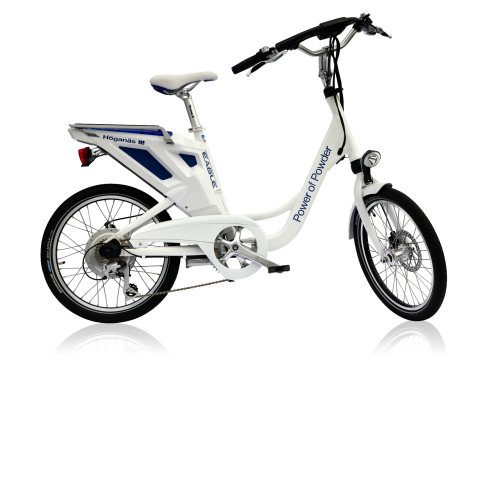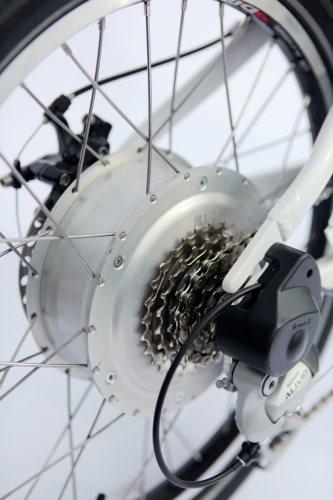

Electric bicycles, while less known in Western Europe and the US, are one of the most popular vehicles used for transportation across the world. This popularity has grown in the last few years following economic growth in Asia (always one of the main markets for the vehicles) and a new appreciation for the environmentally-friendliness of the more recent bicycle products – particular those using an electric motor (as opposed to a internal combustion engine). In fact, most electric bicycles (otherwise known as ‘e-bikes’ can be classified as zero-emissions vehicles, as they emit no combustion by-products. They can also reduce traffic congestion, due to their size and weight when compared to cars.
The modern electric bicycle follows the concept of a pedal bicycle with assisting propulsion, but can also be ridden without power. Currently E-bikes are manufactured by a large number of companies including Golden Eagle Bike Engines, the JD Group and Oklahoma-based Staton Inc.
Höganäs’ interest in electric bicycles began in 1997, when it launched an electric bicycle incorporating a motor & controller designed by Newcastle University in the UK and made of Höganäs’ Somaloy soft magnetic composites (SMC). It was fitted into a standard but sporty bike, with outer gears. However, the company reports, “the Asian market was however not very large at that time, and technology has improved substantially in the meantime.”
Since then the Asian economy has grown exponentially and is now the biggest market in the world for electrical bicycles. At the beginning of 2010, there are around 120 million ‘e-bikes’ in China and annual sales are around US$11 billion. At the same time production of non-electrical bicycles, has fallen by more than 25%.
Targeting China
It was not until 2009 then that the company started developing a Modulated Pole Machine (MPM) for a new generation of electric bicycles, specially targeted at the Asian market.
The development of the motor was also encouraged by what Höganäs calls “the increasing importance of environmentally friendly and clean products as well as the adjustments and regulations made by the Chinese government in the electric bicycle industry.” This government has encouraged the use of this kind of bicycles by banning petrol-fuelled scooters in some parts of the country and encouraging the application of lighter materials in their manufacture.
The company then began to research ways to optimize a complete motor design with all its components, their processing and the final assembly of the motor. They came up with the Modulated Pole Machine (MPM), an electric motor based on powder metal (PM) technology and suitable for the Eagle E-Bike, which was launched in March 2009 by Taiwan-based JD Group.
The MPM is also made from the company’s SMC pressed and heat-treated metal powder components with three-dimensional (3D) magnetic properties. However, the motor topology is different. The main metal constituents are the SMC-material, magnets, copper wire, aluminium and steel. The SMC materials are composed of surface-insulated iron powder particles compacted to form uniform isotropic components with complex shapes. The net-shaping capability of the highly compressible material enables the stator components to be compacted in on single step.
Faster and lighter
Höganäs says that the new motor has a number of benefits over previous models. The metal powder gives it a lower weight and more compact design. “It is lighter than other electric motors and in the e-bike it has a good range, up to 75 km,” Höganäs Group CEO Alrik Danielson said. The previous motor, designed by Newcastle University, could reach only up to 20 km, and was around twice the weight.
The motor is easy to assemble making it suitable for large scale, highly automated manufacturing. The motor is also suitable for other applications besides electric bicycles such as electric scooters, other light electric vehicles, fans, pumps and generators, because it is compatible with standard BLDC controllers. The Somaloy material is based on surface coated iron powder particles that have 3D magnetic flux properties. This enables more design flexibility and the motor can be designed for the specific application.
The MPM has been developed to minimise the environmental impact. The stator is based on metal powder manufactured from melted metal scrap which pulverising it with high-pressure gas or liquid, and the motor design can be easily recycled due to the easy separation of parts. It uses fewer rare earth magnets and copper wire than comparable conventional electric motors, due to the electromagnetic design of the motor.
The future
Höganäs’ Modulated Pole Machine (MPM) was launched at the World Expo in Shanghai, which takes place from May to October 2010. Höganäs intends to license and subcontract the production of the motors in autumn 2010. It is already looking at other geographical markets for the motor.
“Choosing China as the primary target market was a natural choice,” said Lars Hultman, director “ElectroMagnetic Applications” at Höganäs. “However, as other geographical markets are expected to grow significantly, such markets will not be excluded.”
The company is also looking at other end user applications for the MPM concept. “The electromagnetic market is one of many sectors Höganäs wants to grow in,” said Hultman. “The development of the MPM concept will continue by adjusting the motor to other applications. The modular concept means that the possibilities are many and more motor models could be expected in the future.”
One specific end user application of the SMC materials is for light vehicle wheel traction. “Traction applications are one of the most interesting opportunities due to their good technological fit and a growing market,” says Hultman.
“We plan to focus initially on light vehicle traction applications such as bikes, scooters and other light vehicles. Later we plan to look at HVAC (such as pumps and fans) and power generation. The global market for e-bikes and scooters is dominated by China which makes the country very attractive – but market conditions are tougher here than elsewhere. Light electric vehicle transportation is expected to grow significantly globally which will open up a range of interesting market opportunities.”




